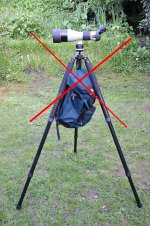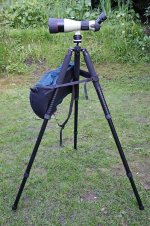John Russell
Well-known member
I'll start off with a few controversial assertions and am open to contradiction:
1) There are no substitutes for leg diameter and weight.
2) The fewer the number of leg sections, the better.
3) Soft surfaces damp better than hard.
4) For a given tripod height it really doesn't matter if you achieve that with the legs or the centre column.
5) Hanging weights from the centre column is contraproductive.
6) There should be metal to metal contact between head and scope, i.e. minimal compliance.
For the tests I set up my Swarovski 65 mm scope on two different tripods, rapped a tripod leg with my index finger and timed the vibrations until they were no longer visible at 30x magnification. The impulse, of course, was variable but I was nevertheless able to achieve fairly reproducible times.
The tripods used were an old Gitzo Series 4 and a basalt Gitzo GT2942L. The Series 4 has three 1,6 mm thick aluminium leg sections of 37, 32 and 28 mm diameter and weighs nearly 4 kg. Gitzo now use a stronger aluminium alloy of only 1,2 mm thickness, which for the same diameter would probably be just as resistant to denting and lighter too, but the elastic modulus doesn't change with the alloy composition, so the old thicker tubes would be 1/3 stiffer.
The basalt tripod has four leg sections of 28, 24, 20 and 16mm diameter and goes up to 151 cm without extending the centre column (161 cm for the Series 4). The stiffness of tubes of the same material is proportional to the material thicknes and to the cube of their diameter, so the top sections of the basalt tripod are over five times as stiff as the bottom sections! Hence the recommendation to keep the number of leg sections to a minimum compatible with height and packing requirements.
Heads used were a Berlebach 552 pan and tilt on the basalt and a Gitzo 1277 ballhead with Novoflex Q-Mount on the Series 4, both Arca Swiss compatible. They are both more than adequate for the little Swaro.
Using just the three top leg sections of the basalt for a height of 120 cm w/o head, vibrations subsided after 3 sec on a heavy woollen carpet and 5 sec on solid wooden flooring. I assumme that vibrations are reflected back into the tripod from the hard surface. Using the top two sections of the Series 4 for a height of 114 cm, the tripod returned instantly to its original position with a half cycle of movement. On the hard surface it was about one full cycle.
With all leg sections extended on the basalt tripod (I had to rotate the angled scope in its collar) it vibrated for 5 sec on carpet and 10-12 sec on the hard surface. In the latter situation the amplitude subsided and then increased again several times due to the interaction of the different tube sections. Hanging 3 kg from the centre column reduced the high frequency vibration time to 5 sec but any pendulum movement of the weight (and this is going to happen in the wind) induced a corresponding low frequency movement of the whole tripod.
Lastly I fully extended the centre column of the basalt tripod but only the top two leg sections, also for a height of 120 cm. Of course the footprint is smaller so the trripod could be more easily knocked over. The vibration time on the hard surface was 5 sec, the same as with three leg sections and collapsed centre column. The centre columns on most tripods are of similar diameter to the top leg sections, so what one loses here is probably compensated by the losses of the thin leg sections.
John
1) There are no substitutes for leg diameter and weight.
2) The fewer the number of leg sections, the better.
3) Soft surfaces damp better than hard.
4) For a given tripod height it really doesn't matter if you achieve that with the legs or the centre column.
5) Hanging weights from the centre column is contraproductive.
6) There should be metal to metal contact between head and scope, i.e. minimal compliance.
For the tests I set up my Swarovski 65 mm scope on two different tripods, rapped a tripod leg with my index finger and timed the vibrations until they were no longer visible at 30x magnification. The impulse, of course, was variable but I was nevertheless able to achieve fairly reproducible times.
The tripods used were an old Gitzo Series 4 and a basalt Gitzo GT2942L. The Series 4 has three 1,6 mm thick aluminium leg sections of 37, 32 and 28 mm diameter and weighs nearly 4 kg. Gitzo now use a stronger aluminium alloy of only 1,2 mm thickness, which for the same diameter would probably be just as resistant to denting and lighter too, but the elastic modulus doesn't change with the alloy composition, so the old thicker tubes would be 1/3 stiffer.
The basalt tripod has four leg sections of 28, 24, 20 and 16mm diameter and goes up to 151 cm without extending the centre column (161 cm for the Series 4). The stiffness of tubes of the same material is proportional to the material thicknes and to the cube of their diameter, so the top sections of the basalt tripod are over five times as stiff as the bottom sections! Hence the recommendation to keep the number of leg sections to a minimum compatible with height and packing requirements.
Heads used were a Berlebach 552 pan and tilt on the basalt and a Gitzo 1277 ballhead with Novoflex Q-Mount on the Series 4, both Arca Swiss compatible. They are both more than adequate for the little Swaro.
Using just the three top leg sections of the basalt for a height of 120 cm w/o head, vibrations subsided after 3 sec on a heavy woollen carpet and 5 sec on solid wooden flooring. I assumme that vibrations are reflected back into the tripod from the hard surface. Using the top two sections of the Series 4 for a height of 114 cm, the tripod returned instantly to its original position with a half cycle of movement. On the hard surface it was about one full cycle.
With all leg sections extended on the basalt tripod (I had to rotate the angled scope in its collar) it vibrated for 5 sec on carpet and 10-12 sec on the hard surface. In the latter situation the amplitude subsided and then increased again several times due to the interaction of the different tube sections. Hanging 3 kg from the centre column reduced the high frequency vibration time to 5 sec but any pendulum movement of the weight (and this is going to happen in the wind) induced a corresponding low frequency movement of the whole tripod.
Lastly I fully extended the centre column of the basalt tripod but only the top two leg sections, also for a height of 120 cm. Of course the footprint is smaller so the trripod could be more easily knocked over. The vibration time on the hard surface was 5 sec, the same as with three leg sections and collapsed centre column. The centre columns on most tripods are of similar diameter to the top leg sections, so what one loses here is probably compensated by the losses of the thin leg sections.
John







